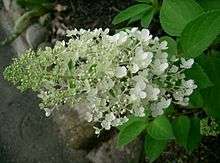Hydrangea paniculata
Hydrangea paniculata, the panicled hydrangea, is a species of flowering plant in the family Hydrangeaceae native to southern and eastern China, Korea, Japan and Russia (Sakhalin).[1][2] It was first formally described by Philipp Franz von Siebold in 1829.[3]
| Hydrangea paniculata | |
|---|---|
| Scientific classification | |
| Kingdom: | Plantae |
| Clade: | Tracheophytes |
| Clade: | Angiosperms |
| Clade: | Eudicots |
| Clade: | Asterids |
| Order: | Cornales |
| Family: | Hydrangeaceae |
| Genus: | Hydrangea |
| Species: | H. paniculata |
| Binomial name | |
| Hydrangea paniculata | |
Description
It is a deciduous shrub or small tree, 1–5 m (3.3–16.4 ft) tall by 2.5 m (8 ft) broad, growing in sparse forests or thickets in valleys or on mountain slopes.[1]
The leaves are broadly oval, toothed and 7–15 cm (3–6 in) long. In late summer it bears large conical panicles of creamy white fertile flowers, together with pinkish white sterile florets. Florets may open pale green, grading to white with age, thus creating a pleasing “two-tone” effect.[4]
Cultivation

In cultivation it is pruned in spring to obtain larger flower heads.[5]
Numerous cultivars have been developed for ornamental use, of which the following have gained the Royal Horticultural Society’s Award of Garden Merit:-[6]
- ’Big Ben’[7]
- ’Limelight’ (PBR)[8]
- ’Phantom’[9]
- Pink Diamond = ‘Interhydia’[10]
- Pinky-Winky = ‘Dvppinky’ (PBR)[11]
- ’Silver Dollar’[12] (suitable for smaller gardens)
Those cultivars marked (PBR) are protected by plant breeders' rights from unauthorised propagation.
Other cultivars include:
- ‘Praecox,’[13] a particularly early flowering cultivar
Uses
Hydrangea paniculata is sometimes smoked as an intoxicant, despite the danger of illness and/or death due to the cyanide[14] present as cyanogenic glycosides.[15]
Etymology
Hydrangea is derived from Greek, meaning ‘water vessel’, in reference to the shape of the capsules.[16]
Paniculata means ‘with branched-racemose or cymose inflorescences’, ‘tufted’, ‘paniculate’, or ‘with panicles’. This name is in reference to the flowers of this species.[16]
References
- Wei Zhaofen; Bruce Bartholomew. "Hydrangea paniculata". Flora of China. Missouri Botanical Garden, St. Louis, MO & Harvard University Herbaria, Cambridge, MA. Retrieved 18 August 2012.
- Hydrangeas for American gardens, by Dirr, Michael. Timber Press, 2004. ISBN 0881926418/ISBN 9780881926415
- "Hydrangea paniculata". International Plant Names Index (IPNI). Royal Botanic Gardens, Kew. Retrieved 10 August 2009.
- RHS A-Z encyclopedia of garden plants. United Kingdom: Dorling Kindersley. 2008. p. 1136. ISBN 1405332964.
- "Youtube - Gardening tips: pruning Hydrangea paniculata". Retrieved 23 June 2013.
- "AGM Plants - Ornamental" (PDF). Royal Horticultural Society. July 2017. p. 51. Retrieved 7 March 2018.
- "RHS Plantfinder - Hydrangea paniculata 'Big Ben'". Retrieved 7 March 2018.
- "RHS Plantfinder - Hydrangea paniculata 'Limelight'". Retrieved 7 March 2018.
- "RHS Plantfinder - Hydrangea paniculata 'Phantom'". Retrieved 7 March 2018.
- "RHS Plantfinder - Hydrangea paniculata Pink Diamond = 'Interhydia'". Retrieved 7 March 2018.
- "RHS Plantfinder - Hydrangea paniculata Pinky-Winky = 'Dvppinky' (PBR)". Retrieved 7 March 2018.
- "RHS Plantfinder - Hydrangea paniculata 'Silver Dollar'". Retrieved 7 March 2018.
- Pfeiffer, Sue A. (2009). "Early Bloomer: Hydrangea paniculata 'Praecox'" (PDF). Arnoldia. 67 (1): 44. Retrieved 2 October 2019.
- Erowid Hydrangea Vault
- ASPCA Animal Poison Control Center
- Gledhill, David (2008). "The Names of Plants". Cambridge University Press. ISBN 9780521866453 (hardback), ISBN 9780521685535 (paperback). pp 206, 289
External links
- Friedman, William. "Eminent panicle hydrangeas." Posts from the Collections, Arnold Arboretum of Harvard University website, 15 July 2019. Retrieved 2 October 2019.
- Rose, Nancy. "A Parade of Hydrangeas." ARBlog, Arnold Arboretum of Harvard University website, 2 July 2016. Retrieved 2 October 2019.